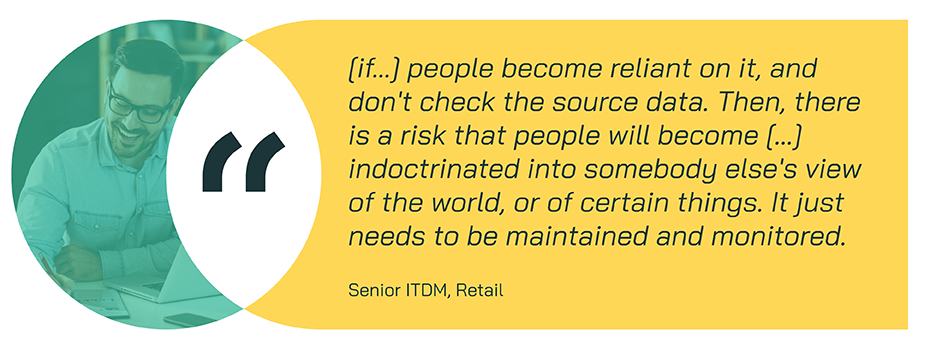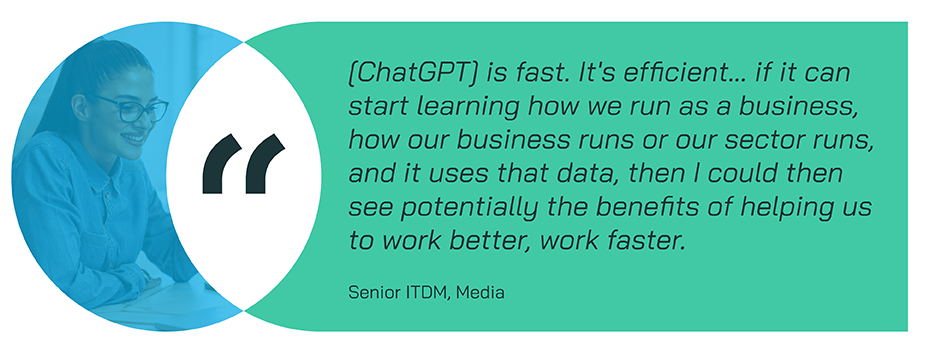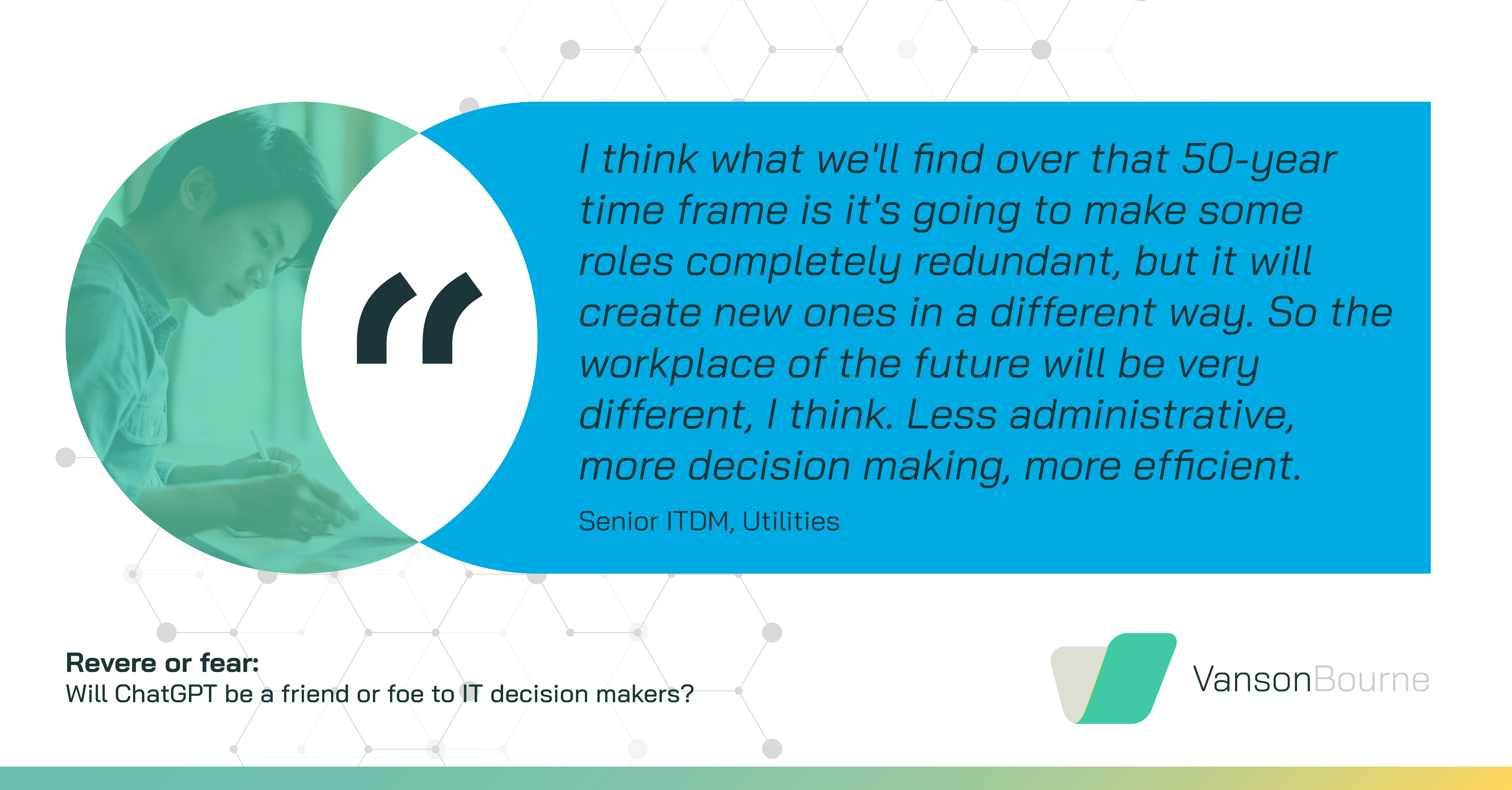Month: July 2023
Blog: Will ChatGPT be a friend or foe to IT decision makers?
ChatGPT and similar AI tools are currently gaining much attraction in the media, with many of us concerned about the possibilities of ChatGPT and similar generative AI tools being used for nefarious purposes. But should (or can we afford to) let these inhibitions hold us back from using some of today’s most exciting technologies? Innovation should be a central focus for all organisations as without it there is a risk of falling behind the competition.
![]()
We wanted to find out how IT decision makers (ITDMs) feel about ChatGPT, both personally and professionally, so we conducted a handful of in-depth interviews with technology leaders from large companies in the UK to gain a rich understanding of their thoughts. Our interviews uncovered a mixture of approaches and attitudes: from companies jumping head-on into ChatGPT usage, to those who currently have banned its use on company devices.
Among ITDMs there is an overarching sense of personal excitement and expectation that the future will be heavily influenced by AI. But will ChatGPT persist, or will it soon be overtaken by other platforms? And will organisations overcome the fear-factor to hone AI as a force for good?

A cautionary approach to AI-generated data
ITDMs acknowledge the ways in which ChatGPT could be detrimental if used for malicious and non-ethical purposes. Perhaps it will make us less productive or enable individuals to take credit for work that is not their own. There are also feelings of doubt surrounding the accuracy of the data, which would need to be verified separately.


This concept of controlling what data sits within ChatGPT and similar AI tools is a key consideration for ITDMs. It manifested itself in different ways in different conversations. Whether it’s to ensure that it is not used to create templates or how-to guides for cyber-attacks, or to prevent misinformation that could, for example, unduly damage company reputation. In one instance, it was suggested that the best way for ChatGPT to be harnessed within an organisation, would be to have it running exclusively with internally approved datasets.

Business snags, but excitement and hype prevail
ITDMs are impressed by the potential for ChatGPT and similar AI platforms, and how it will shape the future, both in a personal and professional capacity. Thinking more specifically about business use cases, chatbots were singled out as something in use but that could be enhanced by further reducing the need for human intervention.
Currently, tools like ChatGPT are helping take out the mundane workloads in organisations, by compiling, generating, and checking documentation. In this way, potential time-savings are immense. One respondent we spoke to reflected on a task that would have taken 4-5 lawyers a whole week, being carried out by AI and machine learning technology in “probably 10 minutes”. Thinking again about the need for organisations to remain competitive, something that can not only save time but also adapt core business models, is worthy of serious investment.

Of course, with certain tasks becoming redundant, people are bound to fear for their jobs. However, ITDMs viewed the impact ChatGPT will have on the workforce as positive overall, in modifying existing roles and opening new opportunities.

But some are held back by reservations and hesitancies surrounding regulations, with one respondent revealing that using ChatGPT on company devices was prohibited at their organisation, and could result in dismissal if something were to go wrong. Whether this is the correct course of action remains to be seen.

The future of ChatGPT
A lot of hype surrounds ChatGPT right now, but there is consensus among ITDMs that as other organisations rush to produce their own versions, it may well be overtaken. Microsoft 365 Copilot is one such product we’ve been advised to look out for. AI in a much broader sense is what ITDMs regard as important and while ChatGPT may be replaced by other tools, there is no indication that AI chatbots will be going away any time soon.

So, what have we learnt about ChatGPT in the view of ITDMs?
It’s clear organisations that embrace and adjust to the ever-changing landscape of AI will be best equipped for the future, whether that includes ChatGPT or another AI chatbot remains to be seen. Job security is not a major concern for our respondents, at least not any time soon, as they perceive the tool as an essential component in alleviating mundane tasks, thereby enhancing worker productivity and enabling them to concentrate on other tasks. However, apprehensions regarding security and control of data, as well as unethical usage, are prevalent among many, potentially impeding the advantageous potential it holds.
Whether you feel optimistic about ChatGPT, or are on the more cautious side, there is no denying that it is gaining attention and having an impact. But will it be replaced by other tools? And will it have more of a positive or negative impact on the workplace?
Only time will tell…
Methodology
Five 30-minute in-depth interviews were conducted in June 2023 with IT decision makers in the UK. All respondents were from organisations in the private sector, with 1,000 or more employees.
As a member of the Vanson Bourne Community you’ll gain access exclusive to a variety of insights reports just like this one, based on research with our members.
Blog: Web 3.0 – A real business game-changer?
With Web 3.0 as a potential game-changer on the horizon, hyped to truly revolutionise the way we do business, we wanted to explore how this innovation is likely to take shape, along with its potential impacts. While Vanson Bourne wouldn’t consider ourselves expert in the subject of Web 3.0, our blog provides a foundation for further exploration on the topic.
Berners-Lee 3.0?!
Before immersing ourselves in Web 3.0 – or Web3 – it’s worth briefly reminding ourselves of the evolution of Tim Berners-Lee’s world wide web since its inception.
- Web 1.0 (the past) – the internet simply provided access to online data. Static web pages, if you will
- Web 2.0 (the present) – internet users can manipulate and interact with content (social media, etc.)
- Web 3.0 (the future) – whilst the concept is still evolving, the essence of the idea is that the web is decentralised and self-regulating. No one entity will have control over the network, effectively creating a more secure and transparent virtual environment
Why should businesses care about Web 3.0?
Forewarned is forearmed -having a solid understanding of the evolving technological landscape, along with the associated organisational opportunities and challenges this creates, can only aid strategic thinking – providing a tactical, commercial, advantage.
Web3 is not purely conceptual, the building-blocks are already in-place, including technologies for storing and transmitting information without governance by any central authority (blockchains), cryptocurrencies, smart contracts, decentralised applications (DApps), peer-to-peer (P2P) networks, non-fungible tokens (NFTs), and decentralised autonomous organisations (DAOs). Each of these already has real-world applications across many industries.
Gaining a snapshot of current business understanding
We recently conducted a poll on our website to find out how many people understand the term Web 3.0. The results can be found here.
To measure the understanding of Web 3.0 across the business community we spoke to IT decision makers across our Community, as well as IT decision makers in the US.
Almost three-fifths (58%) of IT professionals stated that their knowledge of Web3 was not comprehensive. Perhaps unsurprising, at one level, given the future shape and application of such a technology has yet to come fully into view.
Whilst in-depth understanding of Web3 is far from universal, the potential benefits are more widely acknowledged. Adoption of Web3 was felt to have the potential to ensure enhanced data analytics (70%), greater data management (64%), as well as ensure an increased ability to understand customers’ needs (63%).

Given this degree of potential engagement with future applications, it is no surprise that almost 8 in 10 IT decision makers we interviewed felt that the majority of organisations in their industry will employ the technology over the next 5 years.

Positioning you, your team & your organisation for the future
There are a number of practices which can be put in-place to ensure you are you’re well positioned to embrace Web 3.0:
Raising your base knowledge
Being inquisitive, informed and future-facing in terms of ethos -this is no different to when dealing with any such drivers of truly transformational landscape/organisational change.
In more specific terms, ask yourself, your team and your organisation the following questions:
- To what extent do we truly understand the fundamentals underpinning Web3?
- Do we have time, headspace and/or resource dedicated to understanding related movement within our industry vertical? At the very least, is Google Alerts set-up to monitor ‘Web3’/’Web 3.0’ – tracking major sectoral developments
- Has any thought been invested as to how we position our proposition (and brand) within a Web 3.0 landscape?
Keeping a close eye on the pioneers
Within your industry (as well as across adjacent sectors), pay attention to those businesses at the leading-edge of developments, those embracing Web3. Learn from their successes and missteps.
- Which activities/product solutions are they prioritising?
- How are they positioning themselves?
- What problems are they solving?
- How are they adapting their business model(s)?
Focussing upon walking, before running
Start small – look to become gradually more familiar with the foundational concepts of Web3, so that you’re ready to pivot when the opportunity arises.
Our final thoughts
Whether it’s called Web 3.0, Web3, or something entirely different, the third generation of the internet is heading our way. Though such major transformational change may still be five years – or even a decade – off.
Web3 will bring with it the full VUCA (volatility, uncertainty, complexity, ambiguity) suite of impacts and disruption – as is the case with all game-changing innovation. Ultimately though, such seismic transformation can be viewed through the lens of opportunity or challenge.
The most agile, innovative, forward-facing businesses will look to embrace the technology and the associated commercial possibilities, to win.
In our view, the emergence of Web 3.0 should be closely monitored and considered, but not feared. Whilst the foundational technology continues to evolve and integrate, it’s no bad thing to sporadically ask yourself that same, tough, question: ‘Am I, my team and my organisation well placed to embrace such innovation and the opportunities it offers?’
Methodology
The survey findings are based on quantitative interviews conducted in 2023 with Vanson Bourne Community members and additional interviews with IT decision makers from the US. The research comprised of 300 interviews, from enterprise organisations and representing a range of commercial sectors.
As a member of the Vanson Bourne Community you’ll gain access exclusive to a variety of insights reports just like this one, based on research with our members.


